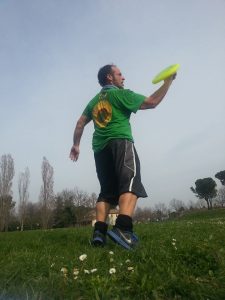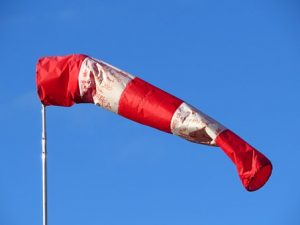Matt Gauthier demonstrate how to do a two handed throw. This throw is perfect for learning how to center nail delay as you can throw it to yourself, it has a decent amount of spin, and it comes to you flat for an easy reception to the nail delay.
Category: Beginner
Articles for the new freestyle frisbee skills player.
How to Get Better at Catching
Ryan Young outlines how he got so good at doing trick catches with a frisbee. Basically its practice and repetition. In the video Ryan goes over a great target, 5 catches in a row for each trick catch you want to master. Ryan suggests under the leg, behind the back, chair, and flamingo are the best to start with.
One interesting observation I’ve made about doing drills. I play freestyle frisbee for the jam. It’s so much fun to succeed with your friends in the jam. Drills seem like work, not fun, and the jam is never about doing repetitions. However, my desire to be a better jammer overcame my distaste for work. I did the drills. In my living room, bed room, at work, on walks, I just kept trying skills. It turns out, the better I got, the more fun I had in the jam. Because of that, the drills never really feel like work. And yes, I still do them. As does Ryan.
What drills do you do to get better at Freestyle Frisbee?
How to Self Throw High Zs
Matt Gauthier explains how to throw high Zzs to yourself. This is very important to be able to practice your nail delay tricks. Being able to throw as much spin to yourself as your partner can throw to you allows you to try all your combos over and over until you have them nailed. Check out Matt’s video for a in depth discussion.
How to Tip a Frisbee, by Ryan Young
Tipping a disc is when you poke the disc with the tip of your finger to pop it back up into the air to keep it in flight. Often, this is one of the first tricks someone will learn after the basic throw and catch. One subtle difference, however, is that many people begin by tipping the disc while it is above their head with their palm facing down or out. Here Ryan shows a more advanced version with the palm up and the disc directly in front of you.
Basically, give yourself a flat throw with lots of spin. Then curl under your pointer finger, hold it with your thumb, and point the remaining finger upwards, with the palm up. Then, tip the disc in the center, over and over. Not too hard, just enough to keep it under control and in front of you.
This is a handy skill that can be placed anywhere in a series of tricks. For example, set the disc under your leg, then tip it. Also, this tip can be made more advanced by adding a restriction. Tip it under your leg, behind your back, or in a bad attitude position. If you want to see how far tipping can go, check out this video of Joey Hudoklin. Might be the most hein tipping combo ever.
Don’t Cut Off the Discs Nose to Spite Your Jam
 The title comes from an old saying, don’t cut off your nose to spite your face. It’s basically when you do something against yourself. Well, like your face, the disc has a nose and how you treat it can make all the difference between success and failure of your next big trick.
The title comes from an old saying, don’t cut off your nose to spite your face. It’s basically when you do something against yourself. Well, like your face, the disc has a nose and how you treat it can make all the difference between success and failure of your next big trick.
The nose of the disc is the highest point of the rim of the disc. Unless the disc is perfectly parallel to the ground, it has a nose. And, the size of the nose refers to how verticle this disc is. A small or slight nose is where the disc is nearly parallel to the ground. So, yeah, maybe you can’t cut it off so to speak. But, where that nose is pointed can dramatically change how the disc will fly. That is, where is the nose relative to the wind.
Imagine a disc flying in the wind. As the air passes over the disc, it will push against different areas of the disc and affect it’s flight. For example, if the nose is pointing towards the wind, the wind will press against the bottom of the disc, helping to lift the disc and keep it in the air longer. If the nose is pointing down wind, the wind will press against the top of the disc and shove it quickly to the ground. If the nose is pointed cross wind then the wind may hardly touch the top of the bottom and the disc will fly more like there is no wind.
So now, imagine you are facing the wind while delaying the disc. You set the disc up into the air so you can do an under the leg pull. As you set it, your (lack of) control will dictate where the nose is pointed. What will make it the easiest to pull disc under your leg? A sight nose into the wind, of course. This will cause the disc to fall more slowly and to drift back towards you so its movement aids in the leg over process.
It’s a very important skill to know how to set any nose amount and direction that you want, but the most important will be a slight nose into the wind. So go practice this set. There are a number of ways to do it, but here are two.

Marco Prati Sets the Disc Into the Wind With Nose
From flat: for clock, take the disc on a center delay. Then lift the disc into the air. As you lift, move your finger slightly to 9 o’clock and then push to 12. The more exaggerated the movement from 9 to 12, the bigger the nose will be. Try this over and over until you can get the nose you want every time. I like to use this to set the disc and going into a spinning pull.
From the rim: for clock, on a rim delay, let the disc rotate to 3 o’clock. Now lift up and let the disc swing on the rim to 6 0’clock. The momentum from the lift will cause the disc to tilt flat. Practice the amount of lift and timing of the rim swing to get the desired nose. I find this easiest on the right hand going from the left side of my body to the right. I like to use it for a scarecrow catch.
How do you set the disc with nose? How much nose do you like for your sets? Let me know in the comments.
Matt Teaches the Rim Delay
In this video, Matt Gauthier teaches how to do a rim delay.
A rim delay is a form of nail delay, or spinning the frisbee on your finger. When most people think of the delay, they think of the frisbee balanced in the center on their finger nail. A rim delay is different. Instead, the inside rim of the frisbee is balanced against the nail. Though a rim delay does take practice to master, it can be faster to learn that the center nail delay. Yet when it is mastered, it provides an enormous depth of tricks and control over the flight of the frisbee. It is truly one of the fundamental skills of freestyle frisbee beyond throw and catch. Check the video for an indepth tutorial on mastering this skill.
Face the Wind
 “Face the Wind.” That’s what my mentor Mike Esterbrook used to tell me over and over when I was a new player. He’d throw me some Zs and I’d take the disc on my nail. Then I’d rim set it under my leg and the disc would quickly fall to the grass. “Face the Wind.”
“Face the Wind.” That’s what my mentor Mike Esterbrook used to tell me over and over when I was a new player. He’d throw me some Zs and I’d take the disc on my nail. Then I’d rim set it under my leg and the disc would quickly fall to the grass. “Face the Wind.”
It took me a while to understand why this is so important. But it can make all the difference between a hein combo and a
early drop. It’s one of those things that makes freestyle look easy while beginners are lost as to why they can’t replicate the big moves. Here’s why you should always face the wind when you have the disc.
First is the concept of a wind shadow. Predictability is one of the most important aspects to completing a trick. One must time the flight of the disc. If the wind is changing under the disc, the flight will be unpredictable. A wind shadow is what happens when something, or someone blocks the wind from the disc. When this happens, the disc falls quickly to the ground. It’s nearly impossible to recover from a wind shadow.
Now imagine your back is to the wind. You set the disc high into the air. It floats nicely down as you prepare for a trick catch. But wait, your body will create a wind shadow. As soon as the disc is in front of you, you are blocking the wind and the disc will fall faster, which will break your timing. Point 3 as we competitor’s like to joke…that’s a drop. If you are facing the wind, you will never wind shadow yourself. Now just get your partner to move out of the way and you are ready.
The second reason to face the wind may be even more important. Part of what makes freestyle frisbee tricks work is the horizontal flight of the disc. That is, it doesn’t just go up and down, it goes side to side. This is what allows it to travel under your leg or pass behind your back for the restricted trick. Without horizontal flight, many restrictions will involve you moving over or around the disc. With horizontal flight you can hold a pose and let the disc do the work as it passes through the restriction.
OK, so if you are doing solo tricks, how do you get that horizontal flight? Well, if you are facing the wind, you can set the disc out, and the wind will blow it back. That’s right, tricks that are seemingly up and down, very often have some form of an out and back aspect. Even many passes are done this way. Like the roll across set.
So what if there is no wind? Well then you make your own wind by running in a specific direction. Your movement through the air causes a relative wind for the disc. This is why you see players chasing after the disc while on an air brushing run.
With face the wind always in mind I eventually developed a new sense. That is, where is the wind coming from. I feel is on my skin and I watch for clues and somehow I always have a sense for where the wind is coming from. Even when jamming indoors. There’s no wind, but I still have an idea of where the wind is. Or more accurately for which direction we are playing. I watch for clues from the other players in the jam. I see which way they are going to create wind and I go the same direction. When we run to close to the wall, we reset and go back the other way.
If you are new to freestyle frisbee then here an experiment for you. Go out to the field with a slick disc. Face the wind and try a simple set to a catch. Then put your back to the wind and try again. You’ll immediately see for yourself what a difference this makes. Then, close your eyes and think, where is the wind. Keep that thought, open your eyes, face the wind and try again. If anyone tries this, please let me know what you learn in the comments below.
Rim Delay
The Rim Delay is one of the 8 fundamental moves in freestyle Frisbee. A large portion of freestyle disc skills and moves depend on knowing this key base skill. Start by throwing yourself spin and letting the disc land on your nail. Then let the disc drift to the rim. Let the disc spin on your nail in the rim until it runs out of spin. Try this on both hands. Next learn to set the disc. Get a Rim Delay as mentioned above, wait for the nose to be up and pointed away from you and push the disc off of your nail. Then progress to with the spin Crank. Get a Rim Delay and follow it around with your hand allowing the disc to travel under your arm.
One Handed Self Backhand Throw
Ryan Young explains how to throw yourself a backhand throw with lots of spin. This is used to practice your nail delay tricks.
The Seven Stages of the Center Delay
Stage 1: Flat Self Throw
Stage 2: Soft Take
Stage 3: Rim Delay
Stage 4: Changing the Angle on purpose
Stage 5: Using the Angle Change to Get Back to the Center
Stage 6: Consistently Getting Back to the Center
Stage 7: Full Center Delay Control


